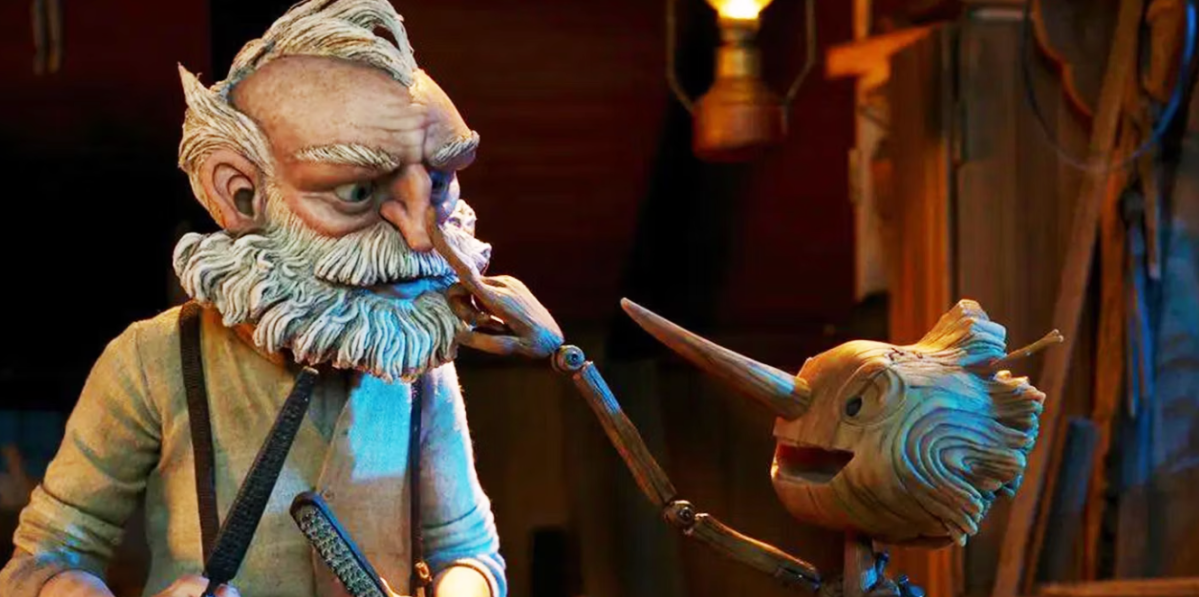Guillermo del Toro’s Pinocchio arrived on Netflix this weekend. Beset by production delays and pipped at the post by Disney’s remake, this iteration of Pinocchio was a challenge to bring to life. Co-directed by Mark Gustafson, it combines del Toro’s familiar style with a familiar story to create something new.
Disney departed from the original tale by giving its hero chipper naïveté instead of outright naughtiness. This new Pinocchio is not entirely likeable: he barrels headfirst into every new situation with no sense of context or consequences. Pinocchio’s exuberance can be more distressing than contagious, which doesn’t always neatly align with the themes of love as a compromise.
Returning the character’s original wickedness helps the motif of lying make more sense, and the visuals of the tree growing from Pinocchio’s nose is one of the film’s highlights. There are other familiar landmarks: a cricket narrating; a blue fairy; a vulpine trickster; a hungry leviathan.
Still, there’s a healthy dose of the Gothic that del Toro always brings: with distinctive Frankenstein influences, the themes of animation and re-animation come to the surface. If one is not truly alive, can one ever die? Is there any incentive to do right by others when there are no personal consequences?
Read: Cabinet of Curiosities, Netflix: Guillermo del Toro’s spooky shorts reviewed
In signature del Toro’s style, it’s set amidst of a political crisis: the plot begins late in WWI and builds directly (very directly) into the rise of Mussolini. This dovetails with an important new aspect of the story: Pinocchio cannot die. His visits to the underworld, where he’s met with a gorgeously-designed angel of death, are the most imaginative scenes in the film.
In the end, though, the narrative dodges away from the question of whether life only gains meaning through the spectre of death. A heroic sacrifice is averted through the power of love. At least this power comes from the whimsically convoluted rules of the fae, interwoven with Christian themes that del Toro fans will recognise from his previous work.
There are beautiful sequences, and a cast that’s somewhat wasted on the small roles: it’s another production where professional voice actors like Tom Kenny vastly outshine screen stars like Christoph Waltz – so it’s unclear why Cate Blanchett’s talent was spent on a grunting monkey.
There are a string of musical numbers, each worse than the last. The strengths are what you’d expect: spectacular creature design, intricate effects like fire and water, and gorgeous settings.
Read: Slumberland, Netflix review: a shining cinematic spectacle
Unlike its protagonist, Pinocchio doesn’t quite stand up without all its strings attached. Compared to Disney’s recent remake, it’s very good. As the longest stop-motion film of all time, it’s a phenomenal achievement. For building on concepts from Hellboy II: The Golden Army and aesthetics from Pan’s Labyrinth, it’s a welcome return to del Toro’s best work.
Being the second stop-motion feature about the underworld to arrive on Netflix this year, it’s not nearly as marvellous as Wendell & Wild (if you haven’t seen it, put it at the top of your list). Now that more famous works are finally slipping free of Disney’s stranglehold on the public domain, Pinocchio might be the beginning of a wave of more creative revisions of classics.
It’s wonderful to be in an era with so many interesting films to choose from, even if some don’t play out quite as well as they could.
Stop motion
Stop motion is a truly fascinating medium to work in. It requires immense labour and craftsmanship to tell a feature-length story, and many are box-office bombs. Still, they tend to garner high critical acclaim and awards in recognition of their folly. In an age where human actors are digitally smoothed into textureless perfection, we cherish the thumbprints and jitters as evidence of the materiality. The flaws are proof of a hard-working puppeteers meticulously crafting each frame. It’s difficult not to marvel at thousands of sculptures, even as they’re fleeting.
There’s a kind of poetry in the ways that Pinocchio fails. It’s a film about sacrifice and consequences, and whether the fleeting joy of the moment is worth the eventual cost. Do we think of things as ‘real’ because they last, or because they end? When the plot of Pinocchio can’t quite make sense of this, the medium steps in.
Stop motion is art for art’s sake. Millions of sculptures will be seen for a fraction of a second before being deconstructed to build the next moment. It’s opulent and imperfect at the same time, like a narrative Rube Goldberg machine.
So it doesn’t matter if it was real, or permanent, or even very good: it was a marvel that wood and clay came to life at all.
Actors:
Director:
Format: Movie
Country:
Release:





